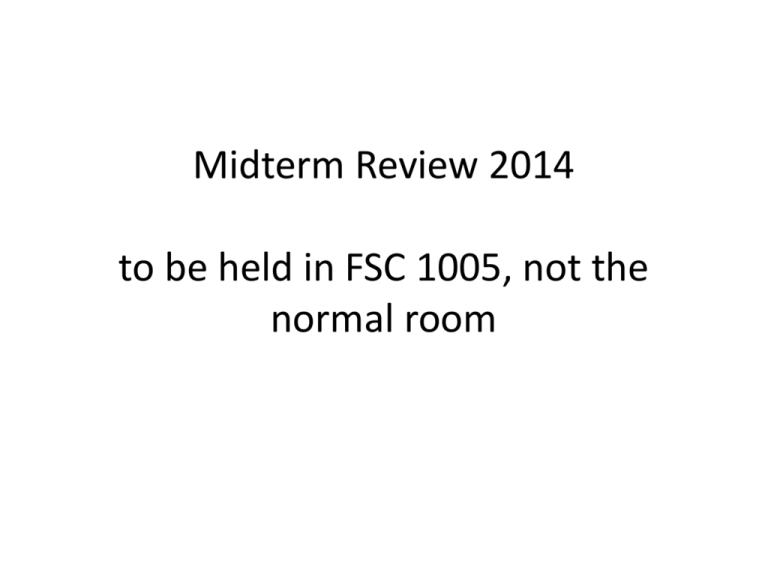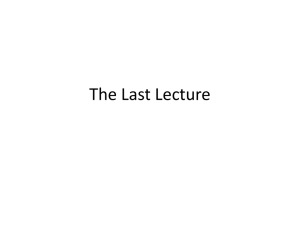Annual Review of Environment and Resources
advertisement

Midterm Review 2014 to be held in FSC 1005, not the normal room • Themes • Readings • Cases How to thrive in exams 3 Analytical Framework: Forces at work in natural resources policy governance policies environment markets actions Consequences 4 Analytical Framework: Forces at work in natural resources policy • • • who decides who participates at what level governance policies environment • • Biophysical characteristics Resource characteristics markets • • • • Prices Exchange rates Supply and demand Trade restrictions actions Consequences 5 Institutions and Governance • Policies are produced through governance processes, influenced by environment and markets. • Governance addresses who decides, who participates, at what level of government, and with which instruments. • Canadian forest policy is dominated by the provincial level of government. • BC’s government is dominated by the executive, particularly the premier. • Courts have played a limited role in forest policy, with the exception of Aboriginal issues, because of the discretionary nature of BC statutes. • Institutional design matters because the balance of preferences may change as the location of authority changes 6 Actors: Strategies and Resources • Actors in the policy process have interests and resources, and adopt strategies designed to best use those resources in pursuit of their interests • Politicians are primarily driven by electoral incentives, making public opinion a significant constraint on government action • Business control over investment gives it a structural advantage • Public opinion is far more influential on policy makers when it is salient • Environmentalists have effectively used marketoriented strategies to increase their power 7 First Nations • First Nations have effectively used the courts to increase their power • The BC government has undergone a profound shift in relations towards First Nations, from active repression through resistance and now apparently sincere efforts at reconciliation November 21, 2013 8 International Influences • Changes in international markets and technology have undercut BC’s comparative advantage • A combination of globally valued resources and reliance on trade makes BC highly vulnerable to international influences • Certification has increased the influence of private standard-setting organizations but there is little evidence of on-the-ground impacts 9 US Influence • US trade pressures have pushed costs up and constrained BC’s policy sovereignty. • BC’s market-oriented forest policy reforms were strongly influenced by trade pressures by the United States 10 5 stage Policy Cycle Model Agenda-Setting Policy Formulation Decisionmaking Policy Implementation Monitoring and Evaluation 11 Policy Cycle Agenda-setting • Issues get on the government agenda through a confluence of problem and politics streams November 21, 2013 12 Policy Cycle Policy Formulation • Policy formulation involves both “thinking” (analysis) and “talking” (consultation with stakeholders) • Collaborative planning or “multistakeholderism” has been a BC success story in land use, but the government is no longer using it November 21, 2013 13 13 readings • Benjamin Cashore, George Hoberg, Michael Howlett, Jeremy Rayner, and Jeremy Wilson, In Search of Sustainability: Forest Policy in British Columbia in the 1990s, (Vancouver: UBC Press, 2001), pp. 3-7, 17, 20-29 (reading packet) • Ministry of Forests, Lands, and Natural Resource Operations, Area-Based Tenure Discussion Paper. 2014. http://engage.gov.bc.ca/foresttenures/files/2014/03/Forest_Tenure_Discu ss_Paper.pdf • Daniel Kahan, “What Is Motivated Reasoning and How Does It Work?, Science and Religion Today May 4, 2011. http://www.scienceandreligiontoday.com/2011/05/04/what-is-motivatedreasoning-and-how-does-it-work/ • George Hoberg, “Ambition Without Capacity: Environmental and Natural Resource Policy in the Campbell Era,” forthcoming in The Campbell Revolution: Power and Politics in British Columbia 2001-2011. 13 readings • Auditor General of BC, An Audit of Carbon Neutral Government, March 2013, http://www.bcauditor.com/files/publications/2013/report_14/repo rt/OAG%20Carbon%20Neutral.pdf, pp 12-31. Note: you are responsible for the general issues and the details of the Darkwoods case, but not responsible for the details of the Encana case. • Special Committee on Timber Supply, Growing Fibre, Growing Value, Victoria: Legislative Assembly of British Columbia, August 2012. http://www.leg.bc.ca/cmt/39thparl/session4/timber/reports/PDF/Rpt-TIMBER-39-4GrowingFibreGrowingValue-2012-08-15.pdf Pp 1-2, 15-16 • Marty Luckert, David Haley, and George Hoberg, Policies for Sustainably Managing Canada’s Forests: Provincial Tenure, Stumpage Fees, and Forest Practices, (Vancouver: UBC Press, 2011), Chapter 1 13 readings • Jason Forsyth, George Hoberg, and Laura Bird, “In Search of Certainty: A Decade of Shifting Strategies for Accommodating First Nations in Forest Policy, 2001-11,” pp. 299-312 in Aboriginal Peoples and Forest Lands in Canada, Vancouver: UBC Press, edited by D.B. Tindall, Ronald L. Trosper and Pamela Perreault. (in reading packet) • Supreme Court of Canada, Tsilhqot’in Nation v. British Columbia, 2014 SCC 44, June 26, 2014. You may find the entire decision interesting to read, but you are only responsible for the case summary (unnumbered pp. 5-11) and paragraphs 67-88 of main decision. • Sarah Pralle, Branching Out, Digging In: Environmental Advocacy and Agenda-Setting. Washington, DC: Georgetown University Press, 2005), Chapter 1 (pp 13-31). (reading packet) 13 readings • Graeme Auld, L. H. Gulbrandsen, and C. McDermott, “Certification Schemes and the Impact on Forests and Forestry,” Annual Review of Environment and Resources (2008) 33 (1):187-211. On line through UBC library http://arjournals.annualreviews.org/doi/pdf/10.1146/annu rev.environ.33.013007.103754?cookieSet=1 • Carl Patton and Sawicki, Basic Methods of Policy Analysis and Planning, (Englewood Cliffs, NJ: Prentice Hall, 1993), 2nd Edition, pp. 52-65 (reading packet) • Drea Cullen et al, “Collaborative Planning in Complex Stakeholder Environments: An Evaluation of a Two-Tiered Collaborative Planning Model,” Society & Natural Resources 2 (2010): 332–350. Read pp. 332-9 only. cases • • • • • • Tenure Midterm Timber Supply Forest Revitalization Plan Softwood Lumber Agreement Great Bear Rainforest Tsilhqot’in case Midterm to be held in FSC 1005, not the normal room






